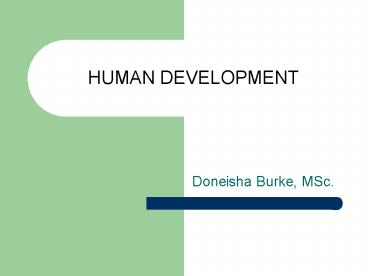HUMAN DEVELOPMENT - PowerPoint PPT Presentation
1 / 33
Title:
HUMAN DEVELOPMENT
Description:
It is the branch of psychology that focuses on the many ways ... Tickling, stroking, poking, bouncing leads to less crying and more eye contact, smiling etc. ... – PowerPoint PPT presentation
Number of Views:147
Avg rating:3.0/5.0
Title: HUMAN DEVELOPMENT
1
HUMAN DEVELOPMENT
- Doneisha Burke, MSc.
2
What is the Developmental Psychology?
- It is the branch of psychology that focuses on
the many ways we change throughout life (Baron,
2001)
3
Development
- refers to the changes over time in the body and
in the thinking or other behavior of a person
that are due both to biology and to experience.
4
When does Human Life begin?
- Human development begins at conception when the
fathers sperm cell unites with the mothers ovum
(egg cell). This one-cell (which is now
fertilized) is called a zygote. - Once the sperm is inside the egg, the head of the
sperm ruptures, spilling the genetic material
from the father (23 chromosomes) into the egg.
There it joins up with the genetic material from
the egg (23 chromosomes) resulting in 46
chromosomes (23 pairs).
5
When does Human Life begin?
- Genetic sex is decided by the father. Normal
chromosomal configuration for the male is XY
XX for the female - The period between conception and birth is known
as the PRENATAL PERIOD
6
PRENATAL DEVELOPMENT
7
Prenatal Stages
- Divided into three stages
- Germinal stage (conception week 2)
- The germinal stage begins when a sperm
penetrates an egg in the act of conception
between a man and a woman. At this point a zygote
is formed. - Embryonic stage (week 3- week 8)
- The embryonic stage occurs once the zygote has
firmly implanted itself into the uterine wall. It
is in this stage that the vital organs are
formed, and while the external body is still
extremely dissimilar from an adult human, some
features such as eyes and arms, and eventually
ears and feet become recognizable.
8
Prenatal Stages
- Fetal Stage (week 9- through birth)
- This is the period when the brain most
substantially forms with the head growing rapidly
compared to the trunk of the body which follows
after. The external genitals also begin to take
shape, fingernails and townails form, eyelids
begin to open and close
9
Prenatal Stages
- Fetal Stage (week 9- through birth)
- This is the period when the brain most
substantially forms with the head growing rapidly
compared to the trunk of the body which follows
after. The external genitals also begin to take
shape, fingernails and toenails form, eyelids
begin to open and close - After 9mths-40weeks-270 days the foetus is fully
developed and is ready to enter the world.
10
Prenatal Influences on Development
- Teratogens
- Factors in the environment that can harm the
developing foetus - Prescription and OTC drugs
- Rubella, genital Herpes and AIDS
- Smoking and Cocaine
- Maternal and Paternal Age
- Maternal Health and Nourishment
11
Physical Development
- During our early years.
12
Physical Development during our early years
- A newborn child is considered a Neonate , esp. in
the first week of life and up to four weeks old. - Physical growth is rapid during this stage
- body weight triples within the 1st year alone
- Babies cant maintain normal body temp until 8/9
weeks old so its imp to keep them warm. - At birth newborns possess several simple
reflexes- an inherited response to stimulation in
certain areas of the body (pg 292 Table 8.1)
13
(No Transcript)
14
Locomotor Development
- Infants ability to move around at birth is very
limited, this however changes quickly. - Motor d-ment moves from the head towards the limb
(Cephalocaudal Pattern of Development).
15
(No Transcript)
16
Locomotor Development
- Motor d-ment is not solely a function of
maturation but has cultural influences which can
either speed up or slow down its d-ment (West
Indian vs. Nomadic societies)
17
Locomotor Development
- There are 3 stages of motor d-ment in children
- Infanthood
- Early childhood
- Later childhood
18
Locomotor Development
- Stage 1
- The first stage is marked by extremely rapid
growth and development, as is the second stage. - By the age of 2 years old, this development has
begun to level out somewhat.
19
STAGE 2- EARLY CHILDHOOD- 2-6 YEARS
- This is characterized as the period of the most
rapid development of motor behaviors - Skills that appear are
- Basic locomotor
- Ball-handling
- Fine eye-hand coordination
- Walking leads to running, jumping, hopping,
galloping, and skipping - Climbing evolves from creeping.
20
STAGE 3- LATER CHILDHOOD- 6-12 YEARS
- The final stage does not have any marked new
developments, rather it is characterized by the
mastering and development of the skills achieved
in the first two stages. - The following characteristics are evident
- By 9 years eye-hand coordination has developed to
being very good - Growth is relatively slow
- This stage is terminated by the onset of puberty
- Motor skills are perfected and stabilized
21
Brain development
- The brain undergoes its most rapid development
during the first two to three years of the
childs life. - After age 3 the rate of the brain growth slows
but continues throughout childhood. - A neonate is born with nearly all their neurons,
however, other areas of brain development occur
after birth. - The most highly developed parts of the brain at
birth are the brain stem and midbrain these
parts are involved in arousal and involuntary
body functions, such as respiration.
22
Brain development
- There is also a thickening of the cerebral cortex
(outer portion of the brain) during the first 3
months of life. - This leads to a development of primary motor
areas (that control limb and other body
movement). - By 6 months, the primary sensory and motor areas
are highly developed.
23
Sensory and Perceptual Development
- How do infants perceive the world around them?
- Can they distinguish between different faces,
smells and touch etc? - How do we find the answer?
24
Sensory and Perceptual Development
- The basis for learning in infants is the sensory
systems of touch, taste, smell, hearing, and
sight. - Sensation occurs when information interacts with
sensory receptors (eyes, ears, tongue, nostrils,
and skin). - Perception is the interpretation of what is
sensed. - All human senses function at some degree at birth
with touch being the most highly developed
25
Sensory and Perceptual Development
- Vision is estimated to be between 20/400- 20/800
at birth leading to unclear vision, by 6mths
vision is 20/100 or better and continues to
improve. - Of all the senses vision takes longer to develop
with eye muscles being very weak leading to poor
eye coordination. - Infants have significantly worse vision than
older children. Infant sight, blurry in early
stages, improves over time. Infants less than 2
months old are thought to be color blind
26
Sensory and Perceptual Development
- Research indicates that infants prefer to look at
patterns (faces, printed matter) and this was
determined by duration.
27
Sensory and Perceptual Development
- Hearing is well-developed prior to birth and
there is a well established preference for the
mother's voice. - Infants are fairly good at detecting the
direction from which a sound comes and prefer
high pitch voices (baby talk) - Infants are esp. attentive to their names and are
able to tell the difference between theirs and
someone else's.
28
Sensory and Perceptual Development
- Taste is highly developed at birth. Infants can
discriminate between the flavors of whatever they
suck on. Sweet flavors are more appealing to them
than salty, acidic, or bitter taste.
29
Sensory and Perceptual Development
- Smell is also highly developed at birth.
- Infants prefer and smile at odors like bananas
vanilla, and turn away from smells such as rotten
eggs fish. - Preference for certain smells also develop
quickly, e.g. lactating vs. non-lactating women
smell of their mother vs. other women
30
Sensory and Perceptual Development
- Touch is a very important sense that has been
found to affect parent-infant attachment,
cognitive development, sociability, ability to
withstand stress, and immunological development. - Infants are born with a fairly well-developed
sense of touch. - Tickling, stroking, poking, bouncing leads to
less crying and more eye contact, smiling etc. - Since touch is such an important foundation for
other skills, it is important to provide frequent
opportunities to use this sense.
31
Sensory and Perceptual Development
- Knowledge of how an infant perceives the world
i.e preference for diff. odours, sounds, voices,
tastes, visual stimuli etc, can serve as a
foundation for infant learning and can be used to
make activities and objects more engaging for
infants.
32
Sensory and Perceptual Development
- An infant's ability to perceive depth has been
studied extensively with an apparatus called a
visual cliff, a box with a glass platform that
extends over a drop of several feet.
33
Sensory and Perceptual development
- An adult (mother or experimenter) stands on one
side of the glass bridge and calls to the child,
who is on the other. Eleanor Gibson and Richard
Walk, in a well-known study, found that at about
6 months babies balk at crawling over the edge of
the cliff. Such a response indicates that depth
perception is present at this age. - Does this ability occur before 6/7 mths?































